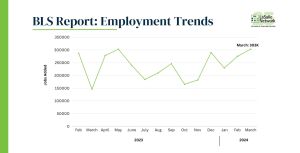In our latest report, we share the 5 pillars of a strong company culture and how they can act as strong retention tools. Download the full report, Retaining Talent in Today’s Great Resignation: 5 Pillars of the Strongest Company Culture, here.
With a low unemployment rate of 3.6%, there is still twice as many available jobs than job seekers, making talent retention a continued focus for many companies across all sectors. The first step to reducing turnover is understanding where it’s occurring and why.
Below we share how to evaluate existing turnover and identify important trends.
Identifying & Addressing Trends
Reframing turnover and what is ‘normal’ for the business and industry is the first essential step to not only addressing attrition but better preparing for it. While turnover was once seen as an indicator of company culture, recently, this is no longer the case. Many businesses are struggling with increased turnover and the baseline for ‘normal’ has shifted. A 10% attrition rate may have been average for many sectors prior to the pandemic, however, those numbers may now be doubling or more. These turnover rates no longer hint at the same potential issues candidates may have been concerned about in the past.
Where/Why is Turnover Happening?
The best way to learn what people want is by asking them directly. Anonymously survey staff to learn what they want more of, what they want to change, and what they want to stop. Consider asking them to provide 2-3 descriptors of how they view the company culture and rate their engagement and job satisfaction levels. Use this data to better understand employees’ perspective and what changes make the biggest difference for them.
Evaluate turnover trends for the last six to 12 months and revisit exit interviews from a range of teams and tenures. While each person may have slightly different values and priorities, there may be common threads that can be addressed.
While there are many reasons people may leave a company, addressing the most prevalent issues can help improve the work conditions for others and make the greatest impact on retention efforts.
Why are People Staying?
Beyond understanding who is at the greatest risk of leaving and why, it is essential to understand why other employees have chosen to stay. To engage the best and brightest before they turn in their letter of resignation, consider conducting “stay interviews.”
A stay interview is a one-on-one conversation between a manager and an employee that serves as a check-in to see how they’re feeling, what they’re motivated by, what’s demotivating them and how they feel about the company, role, team or management. Stay interviews help establish trust and get a pulse on both what employees are satisfied and dissatisfied with. Consider it as a performance review of the company.
What motivates an employee can change quickly, and if the company isn’t offering what they need, the employee can leave for an organization that does. For this reason, stay interviews should not just be done once, but should be part of an ongoing process.
Stay interviews should include questions like:
- What do you like least/most about your role?
- What project would you like to work on that you’re not on currently?
- How do you feel about your team? Who motivates you on the team, and why? Who demotivates you, and why?
- What could we be doing differently to better support you?
Utilize the information gained in these stay interviews to not only learn what employees want but to also make adjustments as needed in order to retain talent. Also consider anonymously surveying staff as a whole to get a pulse on general sentiment and what changes could be made.
While company culture has been a priority for job seekers for years, it has recently grown in importance with job seekers now prioritizing company culture almost as much as pay and benefits. They are placing a strong importance on wanting to feel good about their work, whether it be working for a positive company mission, for strong leaders, or for a team and company they love. This makes a strong company culture not only a tool to attract new talent, but also potentially the best protection against turnover.
In our latest report, we share the 5 pillars of a strong company culture and how they can act as strong retention tools. Download the full report, Retaining Talent in Today’s Great Resignation: 5 Pillars of the Strongest Company Culture, here.







